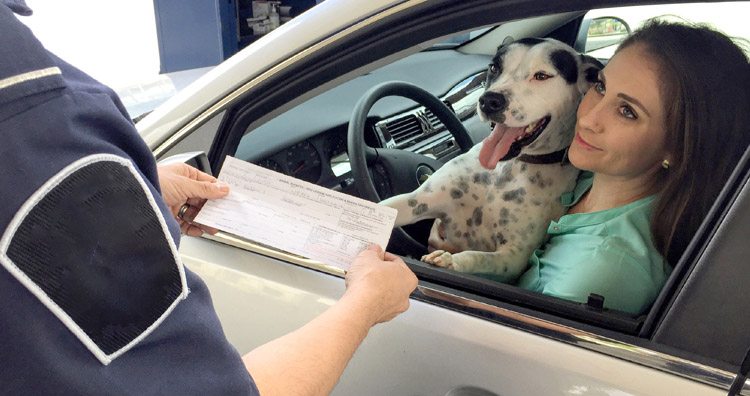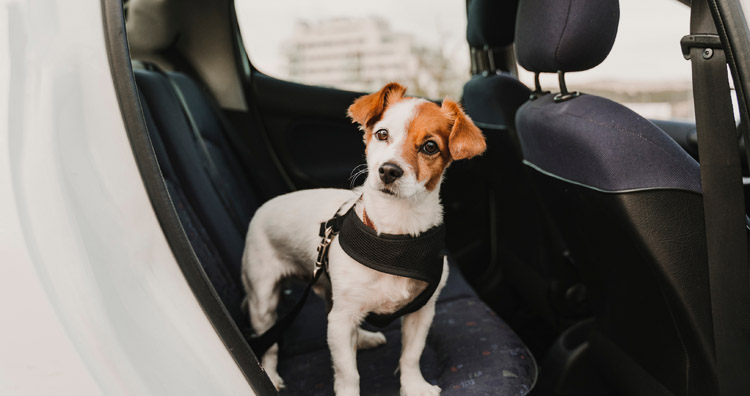- Lifestyle
- 2023
How to travel safely by car with the dog and without surprises
It doesn’t need to be summer. Simply the arrival of a bit of heat is enough for urban dwellers to drive out en masse to relax and enjoy a change of air. Especially now that there are more pet friendly places. Is this your picture? We tell you all you need to know about travelling safely with your dog in the car.
Before starting we fasten our seat belts and see that all the passengers have theirs on too. Why don’t we do the same with the dog? According to the Traffic Authority (Dirección General de Tráfico) (DGT https://www.dgt.es/inicio/ ), more than 50% of drivers go through situations of risk due to not having their animals properly secured in their vehicles. And one in five users carry them without any kind of protection.
A dog on the back seat without any restraint can become a projectile in the event of an accident. According to the RACE https://www.race.es/, driving at 50 kilometres per hour with a dog weighing 20 kilos multiplies his weight by 35. In the event of a sudden stop, it will be as though he weighs 700 kilos. As a consequence, there is a serious risk to his life and to the lives of the other passengers.
What is the law?

The new Animal Welfare Act, which comes into force next September, lays down that the car must have space and guarantee road safety and the dog’s safety during the journey, but does not explain how this is to be done. In any case, if your dog is loose in the car, you can be fined because it is considered to be a distraction just as dangerous as the mobile. Drivers who look away from the road for just two seconds double the risk of being involved in an accident.
Before taking the wheel
You’ve never been on such a long journey with your dog? Then, perhaps you don’t know that your dog is one of those that get carsick. To prevent carsickness (and a disagreeable task of cleaning) consult your vet. Also, for the same reason, feed the dog at least two or three hours before you set out.
It is also essential to plan the route. Experts advise taking a break regularly every two hours approximately. This is easier if you have worked out beforehand where you will stop to stretch your legs and take a walk. Don’t forget to take extra water in case you can’t get it at the service areas.
During the trip
Inside the car it’s better not to give the dog anything to eat while travelling. Dogs can choke if they eat while in movement.
At your stopping points and when you reach your destination, take great care when opening the door or the rear compartment. Your dog will be longing to run and will leap out at high speed, which could be dangerous to him and to the surroundings. Make sure that you hold his lead securely.
Sticking his head out isn’t cool
Maybe you love to show off your dog and, anyhow, we all like to see his ears waving with his head out of the window, don’t we? He likes it because he enjoys the cocktail of smells that he gets when the wind blows in his face. However, he runs the risk of bumping into something, it’s not good for his eyes or his ears and, also, this position means a risk for you because it obstructs the view in the wing mirror.
There is no general law that says expressly that it is forbidden, but if the dog can put his head out of the window it means that he is loose, that he can bother you while you are driving and distract you. Therefore, you can be fined.
In the case that the dog travels loose inside the vehicle and the window is half-open, although he is not leaning out, there is still a potential risk: that he may smell the presence of some other animal such as, for example, a deer on a mountain route, and being unaware that you are driving quite fast, his instinct is to leap out and chase it.
How to secure the dog

It is quite likely that he won’t like being tied down, so you will have to get him used to it with treats and petting to back up his good behaviour. The DGT makes it clear that the dog must never be in the front passenger seat; or on the driver’s lap, which is considered to be totally reckless.
There are various ways of securing dogs in the car, but no standards have been set (either in Spain or in Europe) regarding levels of resistance and the suitability of materials. The weight of the dog should be considered when making your choice. If you choose a harness, it must have a double anchorage (like the systems used for children), with a short and stable attachment. However, in the lack of research on the consequences of impact on the dog, the options considered best at the moment are:
- For a small dog, the safest way is to put him in a pet carrier on the floor behind the front seats.
- For a larger dog, although you may have a dividing barrier separating the seating space from the baggage space, the safest thing is to combine it with a carrier adapted to the size of your travelling companion.
- The best way is to keep the carrier in the baggage compartment, anchored to the back of the rear seats and always across the line of travel.
And if you are still not convinced…
If you still think that keeping the dog firmly secured in the car is not that important, you will do well to know about these risk situations that can occur in the case of an accident:
- Dogs leap out at high speed due to the shock and can be hit by other cars, thereby putting other drivers in danger.
- If you or any of the other passengers need medical assistance, the dog may try to protect you against strangers and not allow the emergency services to come near you.